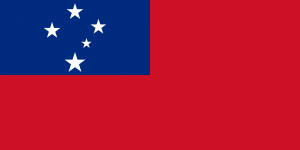Language/Samoan/Grammar/Adjectives
Hi Samoan learners! 😊
In this lesson, we will be learning about adjectives in Samoan grammar. Adjectives are words used to describe or modify nouns, and they are an important part of any language. Samoan adjectives can be used to describe the appearance, color, size, and shape of objects, among other things. By the end of this lesson, you will be able to form sentences using adjectives in Samoan with ease. Let's get started!
Consider exploring these related pages after completing this lesson: Conditional Mood, Plurals & How to Use Be.
Types of Adjectives[edit | edit source]
In Samoan grammar, adjectives are known as taʻiala. They can be divided into three categories:
Descriptive Adjectives[edit | edit source]
As the name suggests, descriptive adjectives are used to describe the characteristics of a noun. In English, examples include "beautiful," "ugly," "juicy," and "spicy." In Samoan, descriptive adjectives come after the noun they describe. For example:
| Samoan | Pronunciation | English |
|---|---|---|
| nisi | nee-see | few, some |
| lafo | la-fo | ripe (for fruit) |
| malolosi | ma-lo-lo-see | big, large |
| tele | teh-leh | many, much |
Here's an example dialogue:
- Person 1: O le isi lā e faʻatau ai le lafo palagi. (We will sell ripe palagi for another day.)
- Person 2: E le o fea mai nisi afi paleni lafo? (Where did some small ripe watermelons come from?)
Possessive Adjectives[edit | edit source]
Possessive adjectives are used to indicate ownership or possession. In English, examples include "my," "your," and "their." In Samoan, possessive adjectives come before the noun they describe. For example:
| Samoan | Pronunciation | English |
|---|---|---|
| aʻu | ah-oo | my |
| lou | loh-oo | your |
| lana | lah-nah | his/her |
Here's an example dialogue:
- Person 1: Ua ou valaʻauina e faia le faʻatoaga ma lou potu. (I have been discussing the event with your boss.)
- Person 2: Ua toe fai lou faʻatalanoaga i lana galuega fou. (You have completed your negotiations for his new job.)
Demonstrative Adjectives[edit | edit source]
Demonstrative adjectives are used to indicate or point to a specific object or objects. In English, examples include "this," "that," and "those." In Samoan, demonstrative adjectives come before the noun they describe. For example:
| Samoan | Pronunciation | English |
|---|---|---|
| nei | neh-ee | this |
| na | nah | that |
| oloa | oh-loh-ah | those |
Here's an example dialogue:
- Person 1: E te le iloa ni matou te tautua i nei aso uma. (We do not know that we will serve every day here.)
- Person 2: Naʻo lou loloto nei e mafai ona tatou taulua oloa ai. (With your height, we can reach those high ones.)
Comparison of Adjectives[edit | edit source]
In Samoan grammar, there are two ways to indicate comparison of adjectives: comparative and superlative.
Comparative Adjective[edit | edit source]
Comparative adjectives are used to compare two nouns. In Samoan, the comparative form of an adjective is made by adding the particle ia at the end of the adjective. For example:
| Samoan | Pronunciation | English |
|---|---|---|
| faʻavae | fah-ah-vah-eh | tall |
Comparative form: faʻavaeia (taller)
Here's an example dialogue:
- Person 1: O le faʻatupulaia le galuega o le ola o le tagata faigaluega ma le gaosiaina. (The work-life balance is getting worse.)
- Person 2: O le vaivai ni faʻavaeia loa o lamālō malolosi. (The problem is how much taller big guys are.)
Superlative Adjective[edit | edit source]
Superlative adjectives are used to compare three or more nouns. In Samoan, the superlative form of an adjective is made by adding the particle atu at the end of the adjective. For example:
| Samoan | Pronunciation | English |
|---|---|---|
| maʻele | mah-eh-leh | short |
Superlative form: maʻeleatu (shortest)
Here's an example dialogue:
- Person 1: Sa laititi ma le malaga o sā tasi o le Falesā, o se isi mea e faʻatuatuaina. (The distance traveled by one of the Falesa family, one thing to be known.)
- Person 2: Sa maʻeleatu pea ona toʻeitu ma taugofie. (It is the shortest and easiest way.)
Conclusion[edit | edit source]
In conclusion, adjectives are an important part of Samoan grammar because they give additional information about nouns. You can use adjectives to describe the size, color, appearance, and other characteristics of an object or person. By learning adjectives, you can enhance your Samoan language skills and communicate better with native speakers. Don't forget to keep practicing and using your knowledge of adjectives in everyday conversations!
To improve your Samoan Grammar, you can also use the Polyglot Club website. Find native speakers and ask them any questions!
➡ If you have any questions, please ask them in the comments section below.
➡ Feel free to edit this wiki page if you think it can be improved. 😎
Well done on mastering this lesson! Don't miss these related pages to expand your knowledge: Give your Opinion & Negation.
Other Lessons[edit | edit source]
- Pronouns
- Conditional Mood
- Future Tense
- How to Use Have
- Questions
- Plurals
- How to Use Be
- Negation
- Give your Opinion
Sources[edit | edit source]

